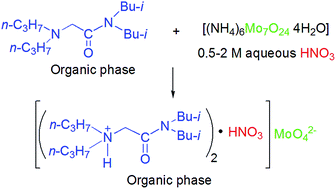A new class of ammonium based anion exchangers embedded with a terminal amide group, viz. α-dialkylamino N,N-diisobutylacetamides has been designed, synthesized and tested for their ability to extract oxometalate anions from nitric acid medium. As a representative example, the molybdate anion has been chosen for the present studies and its extraction behaviour was compared with routinely used anion exchangers like Alamine 336, Aliquat 336 and Primene JMT having no amide functionality. A higher %E value for molybdate was observed with α-dialkylamino N,N-diisobutylacetamides compared to Alamine 336, Aliquat 336 and Primene JMT, from the same HNO3 acidity. The presence of amide group in the ligand is the key to the success of extraction from a relatively higher concentration of nitric acid medium. The amide group in the extractant leads to extra acidity through the intramolecular buffering effect thus enabling the ligand to extract the molybdate anion at higher acidities. Stoichiometry of the ion pair formed during extraction was ascertained by the slope analysis method. The composition of the complex was found to be (LH)2MoO4·HNO3. FTIR and NMR of the loaded extractant indicated that MoO42− is associated with the ammonium site while binding of HNO3 occurred at the amide group.
